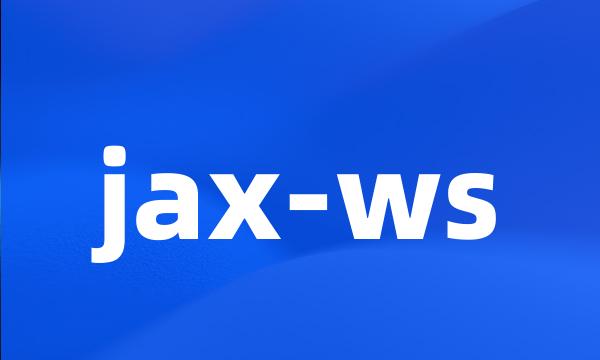jax-ws
 jax-ws
jax-ws-
Next , we want test the generated application using JAX-WS JSPs .
下面,我们想使用JAX-WSJSPs来测试生成的应用程序。
-
So JAX-WS also provides a mapping for the more natural exception .
因此,JAX-WS还提供了更为自然的异常映射。
-
JAX-WS also works with EJB 3.0 to simplify the programming model .
JAX-WS还可以与EJB3.0一起使用来简化编程模型。
-
Java EE 5 also introduces a new programming model for Web services : JAX-WS .
javaEE5还为Web服务引入了一个新的编程模型:JAX-WS。
-
Both JAX-RPC and JAX-WS provide a dynamic client model .
JAX-RPC和JAX-WS都提供了动态客户机模型。
-
It used the J2EE-based Web Service technology and JAX-WS as a Web Service framework .
使用基于J2EE的WEBService技术实现,采用JAX-WS作为WEBService框架。
-
We want to test the service implementation using a synchronous JAX-WS web service proxy client .
我们想用一个同步JAX-WSweb服务代理客户机来测试这个服务实现。
-
It 'll also dig more deeply into JAX-WS usage and features .
我们将更深入地研究JAX-WS的使用和特性。
-
Using JAX-WS , you can deploy a Web service without using deployment descriptors !
使用JAX-WS时,无需使用部署描述符就能部署Web服务!
-
Clean separation of front ends , like JAX-WS , from the core code .
从核心代码干净地分离前端,如JAX-WS。
-
Dynamic programming model : JAX-WS 's dynamic client model is quite different from the JAX-RPC mode .
动态编程模型:JAX-WS的动态客户端模式与JAX-RPC模式差别很大。
-
JAX-WS also adds a dynamic server model , which JAX-RPC does not have .
JAX-WS还添加了动态服务器模型,而JAX-RPC则没有此模型。
-
With JAX-WS , there are two different parameter modes : PAYLOAD and MESSAGE mode .
而对于JAX-WS,有两种不同的参数模式:有效负载(PAYLOAD)和消息(MESSAGE)模式。
-
A major difference between the two models is that JAX-WS also provides an asynchronous invocation model .
两个模型之间的主要差异在于,JAX-WS还提供异步调用模型。
-
Create a new Java project to contain the base Java code for our JAX-WS Web service .
创建新的Java项目以包含用于我们的JAX-WSWeb服务的基本Java代码。
-
JAX-WS 's basic interface mapping model is not extensively different from JAX-RPC 's ; however
JAX-WS的基本接口映射模型与JAX-RPC的区别并不大,不过二者之间存在以下差异
-
This expression matches the web service address of the JAX-WS sample installed below .
这个表达式与下面安装的JAX-WS样例的Web服务地址相匹配。
-
In an actual implementation , you would choose one implementation technology : either JAX-RPC or JAX-WS .
在实际实现中,您将选择一种实现技术:JAX-RPC或JAX-WS。
-
JAX-WS 's data mapping model is JAXB .
JAX-WS的数据映射模型是JAXB。
-
Using CXF , now you can make this an actual service component using a JAX-WS front end .
使用CXF,现在您可以使用JAX-WS前端使其成为实际的服务组件。
-
The pass-thru mediation module in turn calls the JAX-WS web service .
这个直通中介模块反过来调用JAX-WSweb服务。
-
JAX-WS defines a model that uses Java annotations to develop web service providers and web service clients .
JAX-WS定义了一个模型,以便使用Java注释来开发Web服务提供程序和Web服务客户端。
-
Why does a JAX-WS mapping of faults create a fault class and a fault info class ?
为什么错误的JAX-WS映射会创建错误类和错误信息类?
-
Specify JAX-WS JSPs for Test facility , then click Next , then Finish .
将Testfacility指定为JAX-WSJSPs,然后单击Next,然后单击Finish。
-
To generate JAX-WS web services from bottom up using the Java Bean artifacts , complete the following steps
要使用JavaBean工件自下而上生成JAX-WSweb服务,完成以下步骤
-
Test Case # 1 invokes an inline Java bean implementation of the JAX-WS web service logic .
TestCase1调用这个JAX-WSweb服务逻辑的一个内联Javabean实现。
-
He was also one of the Expert Group members for the JAX-WS 2.0 and JAXB 2.0 specifications .
他还是JAX-WS2.0和JAXB2.0规范的专家组成员之一。
-
Some people think that Tango is a different stack than our JAX-WS RI stack .
有些人认为Tango是与我们的JAX-WSRI不同的协议栈。
-
The web service is implemented using the JAX-WS support offered by Integration Designer and the WebSphere runtime platform .
该Web服务使用IntegrationDesigner所提供的JAX-WS支持功能和WebSphere运行时平台来实现。
-
This XML document is automatically bound to the Java domain objects you previously generated with JAX-WS .
这个XML文档被自动地绑定到您前面用JAX-WS生成的Java域对象。
